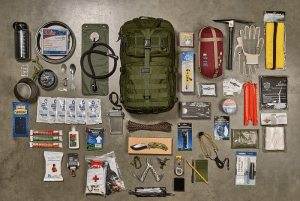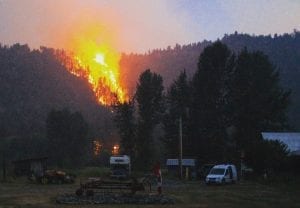Will you be prepared and know when to bug out? The main concern when it comes to disaster is spotting the signs that you should leave your home. Terrorist attacks, breakdowns in society, chemical leaks, and hurricanes can all mean you have to evacuate your city.
But this isn’t always as simple as it sounds. These events can all lead to major evacuation problems when everyone tries to leave at once.
Although it’s important to stay updated on a current disaster’s status, too many people trust that they will be notified by the authorities when it’s time to leave. But the problem is that the agenda and needs of your government are not the same as those of you and your family.
Relying only on your government to manage a disaster is placing your personal wellbeing in the hands of another. And with so much on their plate already, how are you to know that these authority figures will give you the best instructions?
As you can see, relying only on your government to tell you when to bug out is not a good idea. The action and responsibility of evacuating an area lie in your hands as the one evacuating.
Image via YouTube.com
Staying Ahead of the Game
In the circumstance where people are ordered to evacuate, time matters. Oftentimes, people aren’t prepared to leave their homes. And when people aren’t ready either individually or at a federal level, it can result in breakdowns in the area. This includes interruptions in recovery planning, emergency response, and upsurges of crime.
A good example of evacuation complications is the historic Hurricane Katrina. When New Orleans was in the process of evacuating during this disaster, tens of thousands of people were stuck in the city and unable to escape.
The Basics of a Bug Out Plan
If you live in a disaster-prone area or just want to be prepared to survive in case of an unforeseen emergency, here’s where you can start.
A Defined Preparation Plan:
Your preparedness plan should be well-defined, with detailed maps, major roads, alternative routes to major roads listed. You should never leave your home unless you have a plan.
Someone getting ready to leave their home who has a bug-out location in mind is more ready than someone running around their house in a panic trying to pack at the last minute.
Your Bug Out Bag:
As soon as you know when to bug out, it’s time to grab your bug out bag. You should already know exactly what’s on your bug out list and have your bag packed and ready. This will ensure you are prepared for 72 hours of travel getting to your bug out location. Instead of waiting for instructions, try to get ahead of the crowds and leave as soon as you can.
Image via 4chan.org
Have Cash Set Aside:
You should have some cash set aside for this situation. It’s possible that banks and ATMs will be closed at this time.
Prepare your Vehicle:
Your bug out vehicle should already be ready to go before disaster strikes. This means a spare tire in the trunk, a full tank, and a recent oil change.
Essential Knowledge for Bugging Out
Knowledge is crucial for an evacuation plan. Imagine being able to leave hours before the masses start evacuating, all because you had access to information that enabled you to do this. This would give you a huge advantage. Here is what you should stay up-to-date with:
Emergency Advisories:
The television is not the only source of information when it comes to emergencies. You can, for instance, use wireless emergency alerts to stay updated.
Radio Stations:
Find out which station in your area has Emergency Broadcast Stations. You can find this out by looking up your specific area with “Emergency Broadcast Station” online.
Active Weather Alerts:
Natural weather-related disasters are a very common cause of crises. Stay updated on active weather alerts so you know what to expect and when to expect it.
But don’t rely too much on these alert systems. It’s also a smart idea to look around you for signs of when to bug out. Every minute counts for your survival. If you’re not ready to go, you’re losing time that could be critical. Using the resources for communication available to you will give you an advantage.
In addition, gathering information on hypothetical situations ahead of time can help you stay calm when severe weather strikes. This means knowing what to do in case of a tornado, hurricane, or flood (depending on what is most likely in the area you live).
Image via Business.weather.com
Recognizing When to Bug Out
Waiting until you’ve been ordered to evacuate could mean you’ll be too late, even if you’re prepared beyond that. Knowing and acting on the signs is necessary for leaving at the right time. If you already know what you’re looking for, you’ll already be ready to go when disaster strikes. Here are some signs it’s time to bug out:
Increased Law Enforcement:
If you suddenly begin seeing more police or military figures around town, it could mean a disaster is imminent.
You See People Stocking Up:
If you see people stocking up on water and food supplies, it could be a sign to prepare for bugging out.
The News is Warning Citizens:
If your local news station is beginning to mention a possible threat on the horizon, it’s time to prepare to bug out.
Long Lines:
If you start seeing long lines at the gas station, home improvement shop, or bank, it could mean you could have to evacuate soon.
When you decide to stay ahead of the curve, you won’t have to wait behind hordes of stressed evacuees, fight your way through traffic, or try to buy dwindling supplies at the crowded grocery store. When crisis strikes, most people aren’t ready and stress levels are at their highest.
Every individual will have the same goal; getting what they need and leaving town. And if you already have your supplies ready, you’re a step ahead of the rest.
How can you Plan Ahead?
Here are some important tasks you must take care of well before disaster strikes. These will ensure that you and your family are all on the same page and have a better chance of making it to safety.
Set a Bug Out Location:
If your group or family has several members, the odds that you’ll all be in one place when a disaster hits are quite low. Ensure that all family or group members know your plans for bugging out (or bugging in) and that they all know where to meet in case of an emergency.
Secondary Location:
Along with the main bug out location that you will all be heading towards, have at least one (or more depending on the length of the journey) meeting spot along the way. This could be a friend’s house or a spot in the woods.
Communication:
A means of communication such as cell phones or walkie-talkies is recommended so you can keep each other in the loop and make sure everyone is safe.
Alternate Routes:
You should have more than one way of getting to the final bug out location. Odds are high that your main route won’t be accessible for one reason or another, so set some alternate routes and make sure everyone knows them.
Know the Area:
Not only should you know the nearby roads and terrain before bugging out, but you should know where the nearest hospital, grocery store, and gas station are, as well. Along with these crucial areas, also identify potentially dangerous places that should be avoided.
Image via Wheretraveler.com
Be Aware of Dangers and Threats
Recognizing when to bug out depends mostly on you and what your goals are. But it’s always better to play it safe than have regrets later. Evacuating in a very stressful situation is a classic worst case scenario. But this still ends up being the norm for so many people. Here are some common mistakes that people make:
Believing it “Can’t Happen” to You:
A lot of them believe that they are immune to such bad luck, or that unfortunate events only happen to others. They may even wonder what the point is of planning for the worst case scenario. But this exact attitude is what can lead to danger for you.
Waiting Too Long:
Many people who wait for a suggestion from the government to evacuate will end up caught in the chaos of the hordes of people trying to leave at the same time. They also have a higher chance of being one of the stressed out and unprepared drivers on the road, and more susceptible to crime. Waiting too long to leave means your family is likelier to be in jeopardy.
Not Practicing Drills:
Emergency drills are a good way to stay on the same page with your family and prepare for on-the-spot evacuation. This can involve knowing CPR, having an exit plan, and more. At the very least, knowing your family members all have this basic knowledge can ease your mind, so make it a point to practice emergency preparation drills on a regular basis.
Knowing when to bug out and recognizing the signs will be necessary for a safe evacuation. On top of this, it gives you the chance to leave when you’re in the right frame of mind and not surrounded by madness.
When to Bug Out- More Signs to Look For
Many survivalist types putting together their bug out bag and plan want to know how to tell when to bug out. This question isn’t very easy to answer in simple terms as so many disasters can strike with no warning. There’s also the fact that some disasters call for staying put instead of bugging out. How are you to know when it’s time to hit the trail?
Image via Returnofkings.com
If you’re prepared and have already set plans into motion, many emergencies and disasters can be handled by staying at home. But you must also have a plan to bug out, as there could be a scenario that calls for getting as far from home as you can.
If you leave too soon, it may lead to wasting resources and time when you find out that you jumped the gun. If you wait too long, you could end up trapped in your city as everyone else attempts to hastily evacuate and clogs up the roads. The following list should give you a general idea of signs to look for that will alert you about bugging out. Start getting ready to bug out when:
Resources are Running Low
If the situation gets very serious and your basement full of canned goods and other survival necessities starts running out, this is an indicator that it could be time to bug out. The reason I say when they start running out and not when they’re already gone is because you’ll have to have some water and food to bring with you on your bug out journey.
For instance, you might want to have a four-day supply of water and food for you and your family at your place. If a catastrophic event hits and your supplies start running out, this is a sign to prepare to head to your next location. Of course, some situations might call for leaving before this. If not, however, those resources running low means you should move on.
Note that just bugging out for its own sake is not the best idea. But if you find that your survival necessities are getting low and have no access to more, it could be your only choice.
The Area is Unsafe
The crisis you’re going through might be a hurricane, fire, or flood, making your surroundings unfit to remain in. In this situation, you will have to leave your home and possibly your city. Remember that if that happens, you’ll be one of the many people looking for a way to get out of town. The highways and streets in your city could be completely congested with thousands of other citizens. This is just one of the reasons why alternative route ideas are a must.
You Have Somewhere to Go
As mentioned before, you could choose to bug out sooner if you think your bug out location will be safer than your home. If you found yourself in the worst case scenario with a natural disaster, for instance, this would be a sign to head immediately for your bug out location.
Or perhaps you live in an urban location and know that your area has been part of unruly and dangerous protests. You may be aware that the city could be targeted after a police shooting or during a political rally. You could, as a result, decide that it’s safer to spend some time somewhere safer, like your bug out location.
Image via Picalls.com
A lot of people would rather stay at home and keep their property and belongings safe. But is this worth risking your life? Will you know when to bug out? You must know how to weigh the pros and cons in the situation and make the choice that is best for your survival and that of your family. For some people, the safety risks involved with the situation could outweigh keeping their home and belongings safe.
This is a decision only you can make when and if the time comes. You will know your personal situation the best and you and your family can choose in the moment what’s best for you. But it’s recommended that you make a choice ahead of time when you’ll leave home if a situation like this occurs. For example, “When our food is half gone.”
Your Home is or Could be Under Attack
Odds are, this situation won’t happen to you. It’s very unlikely. But on the off chance that your home is under attack from outside forces, this is a good time to head to your bug out location. Most houses in the U.S. aren’t equipped to handle assault from high-powered weapons. The rifle rounds of today can tear through dry wall, mortar, and brick without a problem. For many people, being able to defend their household from looters or attackers won’t be in the cards.
Sadly, drive-by shootings are common in some areas. And during a disaster or crisis situation, these instances could grow. Instead of staying at home and trying to ride out attacks like this, remember that your home won’t provide cover but only concealment. If you are under attack, it’s best to find a safe time to head out.
An attack from something like a simple Molotov cocktail could make your house unlivable in just minutes. And if your situation gets desperate, you might want to preserve your chances of survival by heading out instead of trying to take on a group of attackers.
Getting Caught Unprepared
The reality is, this situation is also very unlikely. But when it comes to constructing a bug out plan, you will want to be ready for all scenarios that could possibly occur. The issue is that emergency possibilities are countless. You can never know for sure what a survivalist situation will consist of. Don’t ever make the mistake of only being ready for one situation. If disaster strikes and your home isn’t equipped to handle it, it might be time to bug out.
Some preppers spend all their time getting ready for a natural disaster. They construct their plans around this expectation and gear up for it. But what if you find yourself in an unexpected emergency that renders these preparations useless? You might run into a medical emergency that can’t be treated at home, leading you to bug out in search of medical assistance.
You should always plan, as much as possible, for the least expected scenario. Sometimes events happen that will catch you off guard, unfortunately. If and when this happens, it will be up to you to decide where to stay, whether it’s time to leave, and how you will go about either.
The Presence of an Increasing Threat
If the emergency and danger you find yourself in are growing and increasing, make sure you know when to bug out. It may be a matter of cutting your losses and getting out while you still have the chance. It could be a fire that is getting dangerously close to your property, or a storm that seems to be getting stronger. Whatever the threat is, when it increases in severity, it’s time to review your options.
Image via Sylvanlakenews.com
If you choose to move on instead of staying put, trust your own judgment and do it without hesitation. One of the best ways to know whether it’s time is to stay updated with the alert systems we mentioned earlier and to watch the news. You might decide to get an emergency radio to have access to weather updates. In a situation where a storm tears down the cell towers in your area, this could save your life.
Keep in mind that bugging out without a destination in mind is a bad idea. Have your plan set up ahead of time so you know exactly where you’re going and when to head there.
Tips for a Safe Bug Out
Once you know when to bug out, it’s time to make a safe, quick exit. Usually, the term “bug out” is used to describe escaping from enemy attackers during a war. But you may need to have a bug out plan to evade home invasions, natural disasters, or other emergency situations. Here are some tips for bugging out safely:
Know your Route
Your bug out route should be not only mapped out and planned to the last detail, but locked into your memory. Do you know where you’ll go if your area is flooded or under attack? Where will you head if there’s a system collapse? Knowing the best direction beforehand will give you the best odds of survival. It will also ensure you find the most suitable routes in an emergency.
If a flood occurs, for instance, a higher path may be necessary instead of routes with low spots or bridges along the way. If you’re dealing with a fire, though, you might have to take an alternate road to avoid hot spots or danger. Keeping up-to-date by listening to local stations can help you know when to bug out and stay ahead of danger.
Just remember that living in an urban city means a higher chance of crowds of people all trying to get out at the same time. Always plan out your routes to avoid as much traffic as possible so you can stay safe and bug out in a timely manner.
Only Carry What is Needed
Some preppers go overboard and compile a collection of bug-out essentials that would fill several backpacks. Would you actually be able to carry all of that? First, ask yourself if you’re approaching this realistically. Your backpack should carry only what is absolutely needed to ensure your survival until you get to your safety location. Check the following:
- Can you walk comfortably for long distances with your bug out bag?
- Are you able to run with your pack on your back?
- Can you climb stairs or jump?
- Try walking up some hills to test whether it’s possible.
Odds are, carrying a heavy backpack will make the above feats difficult or even impossible for you, unless you’ve had extensive military training. Having a bag that is packed too full is only going to slow you down. Make sure your bag is as light as you can make it.
Image via Videoblocks.com
Consider having Multiple Bags
There’s no telling where you’ll be when disaster strikes. Maybe you’ll be at work, or maybe you’ll be at home. You might even be driving when you find that you have to make a hasty escape. Because of this, having multiple bags in multiple locations is a good strategy.
Think about what areas you spend the most time in when you’re not at home. This could be your office or, as stated before, your car. Keep one at work, one in your trunk, and one at home. Even if you don’t end up using them yourself, a friend or family member might get to use one of your backup bags.
Make sure your supplies, such as food, water, a knife, and a tarp, are all packed and ready to go. Put them in an easy-to-reach place to ensure you’ll be able to grab them and run at a moment’s notice. Then, as soon as you know when to bug out, you can leave immediately.
Build a Survival Network
In addition to knowing when to bug out, you should know who to trust in a survivalist situation. You may have certain friends that are trustworthy at work but who would be more of a liability if an emergency struck. Part of a successful bug out plan is building a survival network that is not only trustworthy but that ensures your odds of getting out alive.
Before disaster strikes, get to know your family, your friends, and your neighbors. Be aware of their weaknesses and strengths ahead of time. You could bring up the idea of practicing bug out drills with those closest to you and see how they take it. The ones who refuse or even laugh off the idea of doing these drills shouldn’t be part of your escape plan. Try to choose the friends that take this seriously so you can stay safe. If you don’t know anyone who fits the bill, try joining some survivalist groups online or in your area.
Know your Survival Skills
Knowing your route and having your supplies ready is one thing. But you should also ensure that you have practiced using each item in your bag before you even think about bugging out. Test out your water filtration system beforehand, practice building shelters, and get plenty of shooting practice before your life depends on it. Practice making fires, foraging, and hunting, if applicable.
Be prepared not only for surviving outdoors but also surviving in an urban environment. You may wind up in the city some of the time, even if you’re only looking for food or supplies. Knowing how to blend in when you’re in a city (also known as Urban Camouflage) could be a useful skill for you. This could prevent you from being attacked or robbed.
Image via Shutterstock.com
Work on your Communication Skills
You may think that effective communication skills are a luxury in a situation where survival is your main concern. But think again. People skills are more than likely going to come in handy during your bug-out experience. Maybe you’ll be bugging out on your own and heading to a remote cabin in the wilderness. But even so, what if someone else found it before you when you get there? What if you run into other travelers on the trail to the woods?
Remember that eventually, other people will also be trying to escape and if you’re coming from a highly populated area, it’s almost guaranteed you’ll see someone. Regardless of the specifics, you should be prepared for diffusing or getting out of situations that could be tense or even dangerous for you.
So, where do you start? Do some research on how to avoid interpersonal conflict. Know how to discuss things with strangers without getting them agitated. If you have a relative you tend to argue with, practice getting along with them now. The better you are at avoiding serious confrontation, the better your odds or survival will be.
Conclusion
How is your bug-out scenario going to play out? Will you know when to bug out? By observing the guidelines in this article, you’ll have a better chance of avoiding disaster. Make sure you’re not only preparing for obvious situations, but also unlikely scenarios. Think ahead, be prepared, and you’ll be likelier to survive the unthinkable.









